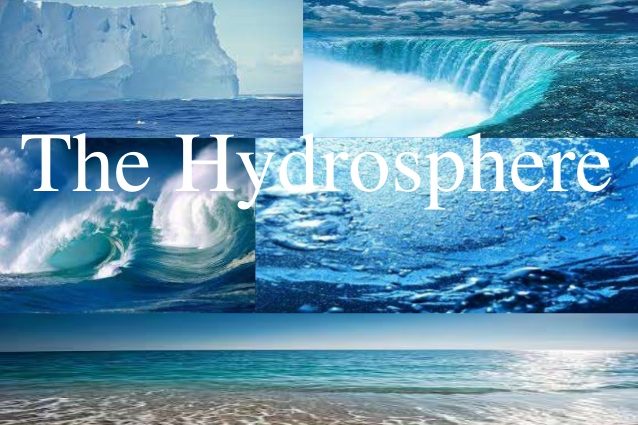The hydrosphere is the total amount of water on a planet.
The hydrosphere includes water that is on the surface of the planet, underground, and in the air.
In Hindi Language Hydrosphere is known as ” JAL MANDAL”. Jal means Water and Sphere means Mandal.
A planet’s hydrosphere can be liquid, vapor, or ice. On Earth, liquid water exists on the surface in the form of oceans, lakes and rivers.
On Earth, liquid water exists on the surface in the form of oceans, lakes and rivers. It also exists below ground—as groundwater, in wells and aquifers. Water vapor is most visible as clouds and fog.
The frozen part of Earth’s hydrosphere is made of ice: glaciers, ice caps and icebergs. The frozen part of the hydrosphere has its own name, the cryosphere.
Video On Hydrosphere
Water Cycle
Water moves through the hydrosphere in a cycle. Water collects in clouds, then falls to Earth in the form of rain or snow. This water collects in rivers, lakes and oceans. Then it evaporates into the atmosphere to start the cycle all over again. This is called the water cycle.

Interactions of the hydrosphere
It is important to realize that the hydrosphere is not an isolated system, but rather interacts with other global systems, including the atmosphere, lithosphere and biosphere. These interactions are sometimes known collectively as the water cycle.
Atmosphere: When water is heated (e.g. by energy from the sun), it evaporates and forms water vapour. When water vapour cools again, it condenses to form liquid water which eventually returns to the surface by precipitation e.g. rain or snow. This cycle of water moving through the atmosphere and the energy changes that accompany it, is what drives weather patterns on earth.
Lithosphere: In the lithosphere (the ocean and continental crust at the Earth’s surface), water is an important weathering agent, which means that it helps to break rock down into rock fragments and then soil. These fragments may then be transported by water to another place, where they are deposited. These two processes (weathering and the transporting of fragments) are collectively called erosion. Erosion helps to shape the earth’s surface. For example, you can see this in rivers. In the upper streams, rocks are eroded and sediments are transported down the river and deposited on the wide flood plains lower down.
On a bigger scale, river valleys in mountains have been carved out by the action of water, and cliffs and caves on rocky beach coastlines are also the result of weathering and erosion by water. The processes of weathering and erosion also increase the content of dissolved minerals in the water. These dissolved minerals are important for the plants and animals that live in the water.
Biosphere : In the biosphere, land plants absorb water through their roots and then transport this through their vascular (transport) system to stems and leaves. This water is needed in photosynthesis, the food production process in plants. Transpiration (evaporation of water from the leaf surface) then returns water back to the atmosphere.
Man Collects The Water Too
Not all collections of fresh water sources are created by nature. There was a need to collect and save as much fresh water as possible as civilization grew.
Reservoirs were invented to serve that need. They are huge containers that are man-made lakes. When the rainy season comes, the water collects and is stored. During the dry season, there is plenty of water.
Humans have also used smaller devices to collect water called water towers.
If you ever need to make a reservoir, you need a dam that will stop water from running out of a valley. Instead of draining to lower elevations, the water will fill the valley.
WAYS TO PROTECT AND CONSERVE HYDROSPHERE
- Go Native : Use native plants in your landscape. They look great, and don’t need much water or fertilizer. Also choose grass varieties for your lawn that are adapted for your region’s climate, reducing the need for extensive watering or chemical applications.
- Reduce Chemical Use : Use fewer chemicals around your home and yard, and make sure to dispose of them properly – don’t dump them on the ground!
- Manage Waste : Properly dispose of potentially toxic substances like unused chemicals, pharmaceuticals, paint, motor oil, and other substances. Many communities hold household hazardous waste collections or sites – contact your local health department to find one near you.
- Don’t Let It Run : Shut off the water when you brush your teeth or shaving, and don’t let it run while waiting for it to get cold. Keep a pitcher of cold water in the fridge instead.
- Fix the Drip : Check all the faucets, fixtures, toilets, and taps in your home for leaks and fix them right away, or install water conserving models.
- Wash Smarter : Limit yourself to just a five minute shower, and challenge your family members to do the same! Also, make sure to only run full loads in the dish and clothes washer.
- Water Wisely : Water the lawn and plants during the coolest parts of the day and only when they truly need it. Make sure you, your family, and your neighbors obey any watering restrictions during dry periods.
- Reduce, Reuse, and Recycle : Reduce the amount of “stuff” you use and reuse what you can. Recycle paper, plastic, cardboard, glass, aluminum and other materials.
- Natural Alternatives : Use all natural/nontoxic household cleaners whenever possible. Materials such as lemon juice, baking soda, and vinegar make great cleaning products, are inexpensive, and environmentally-friendly.
- Learn and Do More! : Get involved in water education! Learn more about groundwater and share your knowledge with others.

